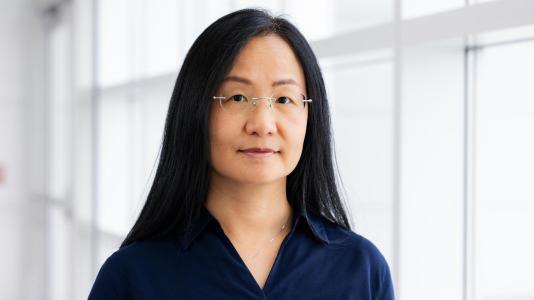The physicist oversees a portfolio of refurbishments to the linear accelerator at the Advanced Photon Source
By Jenna V. Wray | May 21, 2025
Her leadership enables Argonne to continue pushing the boundaries of accelerator science.
“It’s a wonderful time to be at the Advanced Photon Source,” Yine Sun says.

It’s easy to understand why. The Advanced Photon Source (APS), a U.S. Department of Energy (DOE) Office of Science user facility at DOE’s Argonne National Laboratory, is in the final stages of a comprehensive upgrade that has made it the brightest synchrotron X-ray light source in the world.
While most of the attention for those brighter X-ray beams is focused on the new electron storage ring at the heart of the APS, it all starts with some electrons in a long tube called a linear accelerator. The LINAC, for short, is the first link in the chain of accelerators that delivers ultrabright light to scientists for research, and Yine Sun is the woman in charge of keeping it running.
“Light sources around the world are watching us as upgraded beams come online, setting new operation milestones along the way. It’s a privilege to be here, to see first-hand how the APS is pushing the limits of accelerator beam physics.” — Yine Sun, Argonne National Laboratory
Sun is the leader of the Accelerator Operations and Physics group at the APS, and she heads a team dedicated to the LINAC. She oversees a portfolio of refurbishment projects geared toward modernizing what is one of the oldest parts of the accelerator complex and collaborates with many technical groups at the APS to make that happen.
Her journey to Argonne was a long and winding one. Sun was born in a small village near the Yellow River in China. From an early age, she was encouraged to pursue her academic talents, especially in science, technology, engineering and math (STEM).
“Where I grew up, education was valued for girls as well as for boys,” she said. “My interest in STEM was noticed and nurtured.”
It was quite a change for Sun when she moved to Beijing, the second-largest city in China, to study physics at Peking University. Her pursuit of learning took her further, to the United States, where she earned her doctorate from the University of Chicago.
Her advisor, Argonne emeritus Kwang-je Kim, introduced her to the exciting world of accelerator physics. Soon, she was doing research on electron beams. Through Kim, she also learned about the cutting-edge science being done at Argonne. After graduating, Sun built a career at DOE laboratories.
In 2013, she joined the APS.
Recalling what brought her there, Sun said, “The APS was upgrading the LINAC, installing a new mechanism to generate brighter beams. Argonne was at the forefront of accelerator science with an excellent team of accelerator physicists, and I had to be a part of it.”
Sun values Argonne’s continued efforts to push the boundaries of what’s possible in accelerator technology. Most recently, this has taken the form of the APS Upgrade project, which included the installation of a new storage ring. The new ring utilizes a multi-bend achromat lattice, which reduces beam emittance (the extent to which the beam is spread out).
“The APS currently holds the world record for smallest emittance for X-ray synchrotrons, and the smaller the beam, the brighter the light,” Sun said, smiling as she concluded, “The better the images.”
To make the upgrade and the operation of the APS accelerators happen, teamwork is key. Sun is often amazed by the commitment of her colleagues.
“I’m in awe of the support system at the APS,” she said. “The people here are world-class experts at what they do and willing to help promptly. They are so dedicated to keeping the APS operating with excellent beamtime availability.”
Sun does her part to advance the field through her work in research and development. Her group is expecting to receive a new photo-cathode laser this summer. The new laser will allow for electron beams with higher energy for the LINAC. It will also generate brighter beams for the LINAC Extension Area, where experiments aimed at shaping the future of accelerator technology and beam physics will be conducted.
Sun believes the multidisciplinary nature of the work at the APS makes it a wonderful place for young scientists to gain experience. Post-doctoral positions are available in many fields, including physics, engineering and computer science.
“Light sources around the world are watching us as upgraded beams come online, setting new operation milestones along the way,” she said. “Many people want to sit in our control room to witness it. It’s a privilege to be here, to see first-hand how the APS is pushing the limits of accelerator beam physics.”
